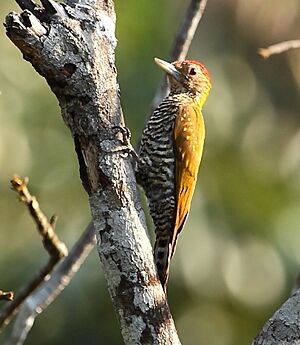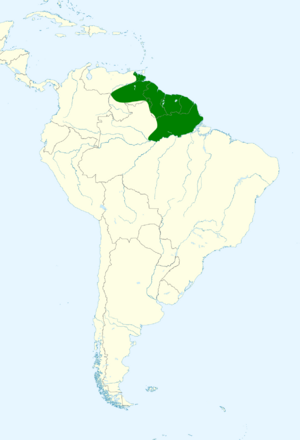Golden-collared woodpecker facts for kids
Quick facts for kids Golden-collared woodpecker |
|
|---|---|
 |
|
| A male at Manaus, Amazonas state, Brazil | |
| Conservation status | |
| Scientific classification | |
| Genus: |
Veniliornis
|
| Species: |
cassini
|
 |
|
| Synonyms | |
|
Dryobates cassini |
|
The golden-collared woodpecker (Veniliornis cassini) is a colorful bird from the woodpecker family. You can find it in countries like Brazil, the Guianas, and Venezuela.
Contents
About This Woodpecker
How Scientists Classify It
Scientists group animals to understand them better. The golden-collared woodpecker is usually placed in the Veniliornis group. However, some scientists have moved it to the Dryobates group.
This woodpecker is a unique species. Another bird, the Choco woodpecker, was once thought to be a type of golden-collared woodpecker. But now, they are known as separate species.
What It Looks Like
The golden-collared woodpecker is about 16 cm (6.3 in) long. It weighs between 24 to 38 grams (0.85 to 1.3 oz). Males and females look very similar, but their heads are different.
Males have a red crown on top of their heads. Females have a brown crown with a green tint. They also have yellowish spots on the back of their heads.
Both sexes have a light-colored face with thin, dark lines. Their neck is bright golden-yellow. Their upper body is mostly yellowish-green with a shiny bronze look. Their wings are dark brown with white bars. Their tail is dark brown with lighter bars.
Their belly is white or light cream with black stripes. They have dark brown eyes and a dark gray beak. Their legs are olive green to dark gray. Young woodpeckers look like adults but have a darker face. Both young males and females have some red on their crowns.
Where It Lives
The golden-collared woodpecker lives in parts of Venezuela, the Guianas, and northern Brazil. It prefers to live inside rainforests. You can also find it in clearings within these forests. It likes open areas with trees and bushes too.
These birds live from sea level up to about 1,500 meters (4,900 ft) high.
Woodpecker Behavior
Movement and Home
Scientists believe the golden-collared woodpecker stays in the same area all year. It does not migrate to other places.
What It Eats
This woodpecker usually looks for food by itself. Sometimes, it joins groups of different bird species. It often searches for food high up in the treetops.
We don't know all the details of its diet. However, we do know it eats Cerambycidae beetles.
Reproduction and Family Life
Sadly, not much is known about how the golden-collared woodpecker raises its young. Scientists are still learning about its breeding habits.
Sounds It Makes
The golden-collared woodpecker is usually a quiet bird. It doesn't make a lot of noise. When it does, it makes a series of 33 to 35 nasal "khir" sounds. These sounds get higher in pitch. It can also make a loud, rattling trill sound.
Status and Safety
The IUCN (International Union for Conservation of Nature) says the golden-collared woodpecker is a species of "Least Concern." This means it is not currently in danger of disappearing. It lives across a large area. Even though we don't know its exact population size, it seems to be stable.
No major threats to this bird have been found. It is a very shy woodpecker that lives in the treetops. This makes it hard to see and study. It might be more common than we think!


